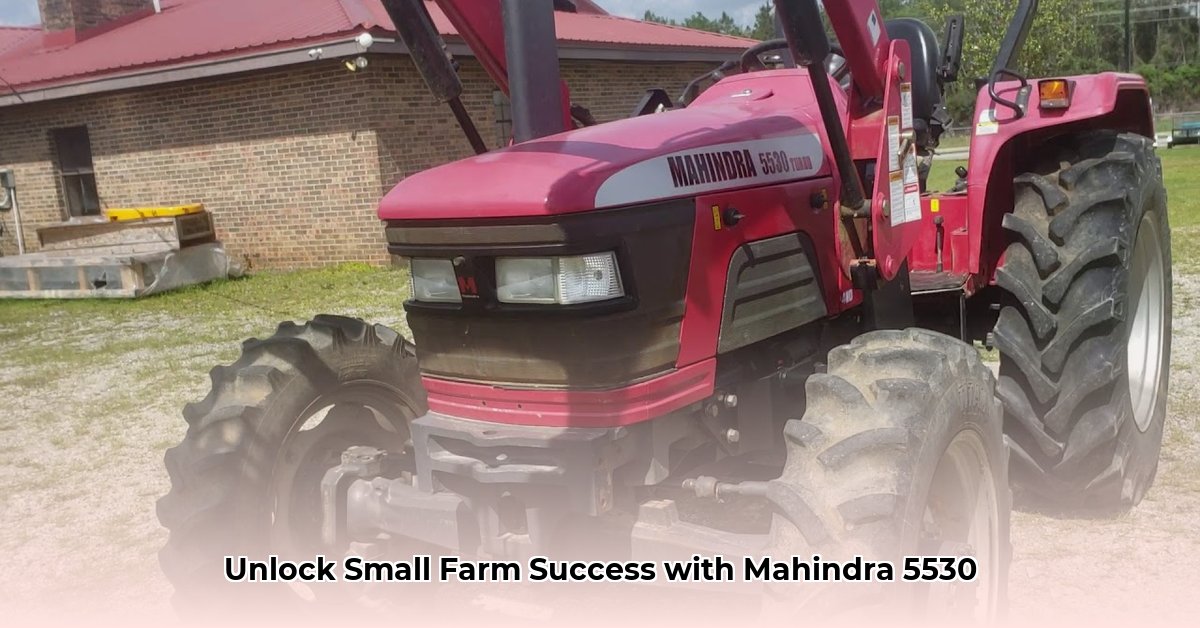
Understanding the Mahindra 5530 Tractor
The Mahindra 5530 tractor offers a compelling proposition for smallholder farmers seeking a reliable and affordable workhorse for sustainable agricultural practices. This comprehensive guide analyzes its capabilities, costs, and suitability within a sustainable farming context, providing actionable recommendations for farmers, dealers, and policymakers. We'll explore its technical specifications, performance, cost-benefit analysis, and practical strategies for maximizing its efficiency and minimizing its environmental impact. For more in-depth technical specifications, visit the Mahindra 5530 website.
Technical Specifications and Features
The Mahindra 5530 boasts a 55-horsepower, three-cylinder, 2.5-liter engine, providing sufficient power for various small-scale farming operations. Its key features include:
| Feature | Specification (Example Values - Consult Manufacturer's Specifications) |
|---|---|
| Engine | 2.5L, 3-cylinder diesel |
| Horsepower | 55 HP |
| PTO Power | (Specify PTO horsepower) |
| Hydraulic Lift | (Specify lift capacity) |
| Fuel Tank Capacity | (Specify tank capacity in liters/gallons) |
| Transmission | (Specify transmission type) |
Its relatively simple design contributes to ease of maintenance, reducing downtime and repair costs. However, its power limitations restrict its suitability for large-scale or heavy-duty applications.
Performance and Sustainability Assessment
The Mahindra 5530's affordability and versatility are significant strengths for smallholder farmers. Its ability to handle a wide range of tasks makes it a valuable asset for diversified farming systems. However, its fuel efficiency is a notable weakness compared to newer, more technologically advanced tractors. Higher fuel consumption directly impacts operational costs and increases the tractor's environmental footprint. Does this negate its value in sustainable farming? Not necessarily. Its cost-effectiveness allows for entry into mechanization, a crucial step towards improving efficiency and reducing manual labor.
Fuel Consumption and Environmental Impact
Higher fuel consumption compared to newer models is a key concern. However, careful management of tasks and driving techniques can mitigate this impact to a degree. This is where smart task selection (avoiding overloading or using it for tasks beyond its capacity) and regular maintenance become crucial components of sustainability.
Suitability for Different Farming Contexts
The Mahindra 5530 shines in diverse, smaller-scale operations where its versatility offsets its comparatively lower fuel efficiency. It’s well-suited for tasks such as tilling, plowing, planting, and harvesting smaller plots. However, large-scale operations or those requiring heavy-duty power might find it lacking.
Cost-Benefit Analysis
The initial purchase price of the Mahindra 5530 is generally lower than many competitors. This lower upfront cost is a substantial advantage for farmers with limited capital. However, the long-term cost must include fuel, maintenance, and potential repairs. A thorough cost-benefit analysis should assess:
- Initial Investment: Purchase price (new or used).
- Running Costs: Fuel consumption, routine maintenance, and potential repair costs.
- Return on Investment (ROI): Increased productivity, reduced labor costs, and potential yield improvements.
Comparing these costs against expected returns across different farming scenarios is essential for determining its financial viability.
Actionable Recommendations
To maximize the Mahindra 5530's contribution to sustainable farming, consider these strategies:
For Smallholder Farmers:
- Match tasks to capabilities: Avoid overloading the tractor; prioritize appropriate implements.
- Preventative maintenance: Regular servicing minimizes breakdowns and extends the tractor's lifespan.
- Fuel-efficient practices: Minimize idling, maintain optimal tire pressure, and plan efficient routes.
For Equipment Dealers:
- Targeted marketing: Focus on smaller farms, highlighting the 5530's versatility and affordability.
- Efficient parts management: Ensure timely repairs by maintaining an adequate stock of parts.
For Policymakers:
- Financial support: Consider subsidies or loans to help small farmers acquire fuel-efficient tractors.
- Sustainable agriculture programs: Promote practices that reduce reliance on fuel-intensive operations.
Conclusion
The Mahindra 5530 tractor presents a balanced proposition. Its affordability and versatility make it a viable option for many small-scale farming operations focused on sustainability. While its fuel consumption might be relatively higher compared to newer models, careful operation, maintenance, and strategic farming practices can mitigate this drawback. A thorough cost-benefit analysis tailored to individual farming scenarios is crucial before investing in this or any other tractor. Ultimately, the Mahindra 5530's suitability hinges on a farmer's specific needs and their commitment to maximizing its potential within a sustainable agricultural framework.